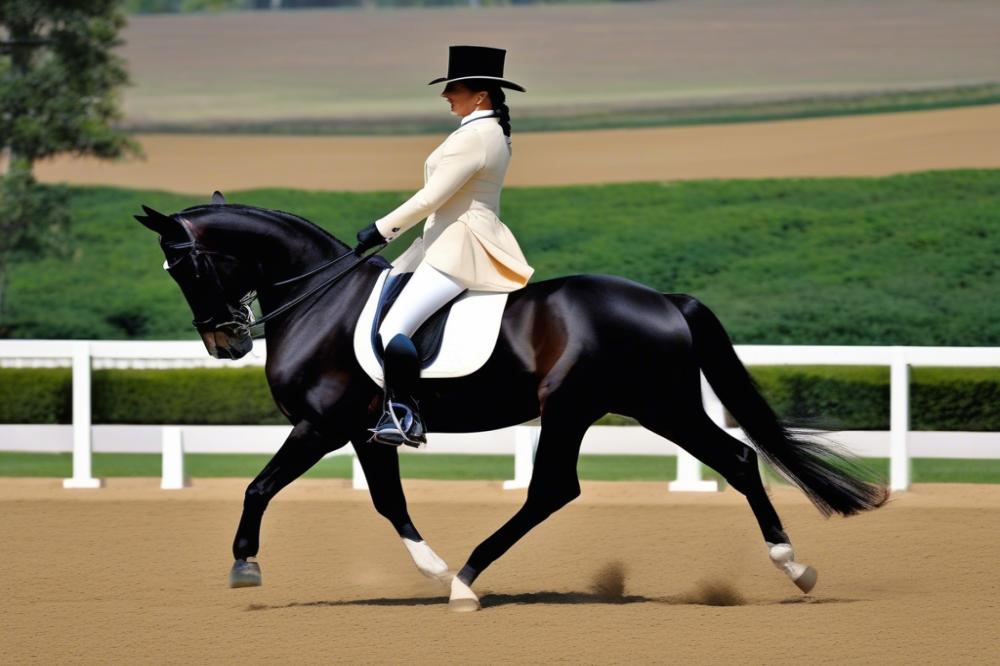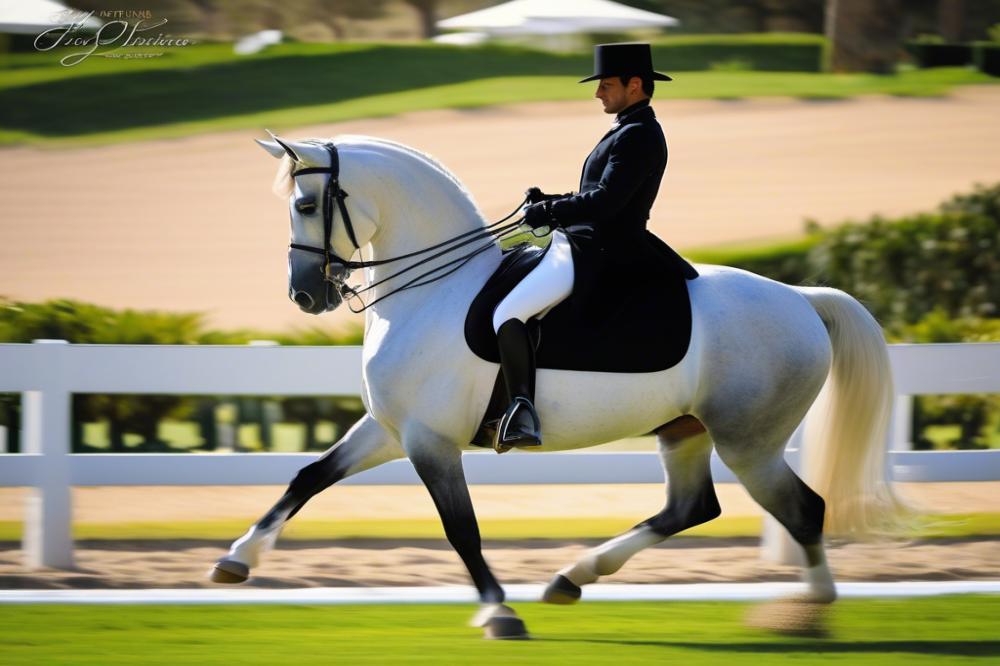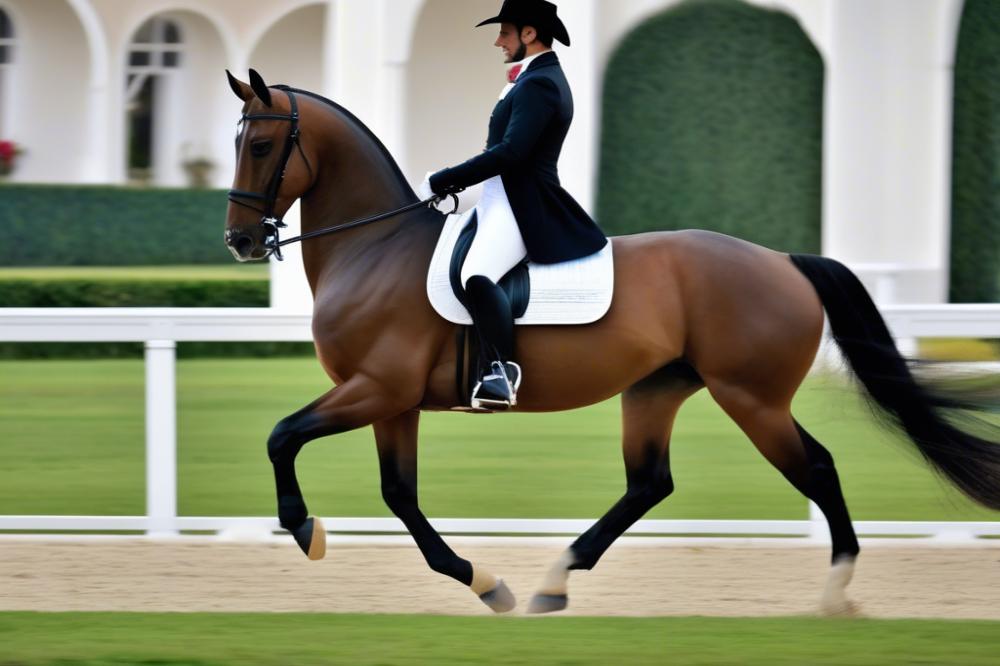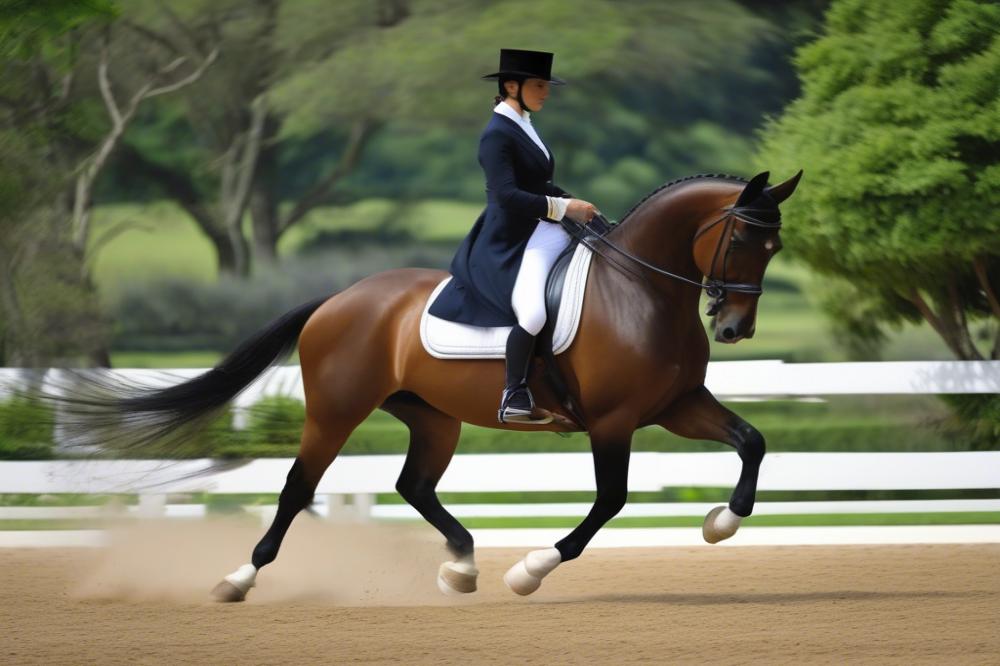Introduction
Lusitano horses are renowned for their grace and athleticism. Originating from Portugal, these animals have a long history in classical riding and are a favorite among dressage enthusiasts. Their strong build and noble temperament make them especially suitable for the intricate movements required in the arena.
riding techniques play a crucial role in how well a Lusitano can perform. Mastering these methods can enhance not only the horse’s movement but also the overall partnership between horse and rider. Classical dressage demands a specific set of skills from the rider. Proper posture, timing, and understanding of rider aids can significantly influence a horse’s performance.
This article aims to delve into the essential elements of riding a Lusitano effectively. Focus will center on riding techniques, correct body alignment, and the use of hands and legs for better communication with the horse. Through mindful practice, riders can develop a deeper connection with their Lusitano, leading to improved performance in the dressage arena.
Lusitano dressage

Characteristics of Lusitano Horses Suitable for Dressage
Lusitano horses are known for their compact build and strong haunches. Their powerful yet graceful physique allows for impressive movements. These animals often exhibit a high degree of intelligence, making them trainable and responsive. Typically, they possess a calm temperament, which is essential for focused work in dressage. A distinct characteristic is their natural ability to perform lateral movements smoothly. Riders appreciate the horse’s balance, which promotes good posture during performances.
Unique Traits and Advantages of Riding a Lusitano
Riding a Lusitano offers several advantages. Their agility and stamina stand out, allowing them to excel in various dressage exercises. The breed is known for its collected canter, which aids in performing advanced maneuvers. Additionally, Lusitanos display remarkable collection and extension capabilities. This versatility makes them effective in transitioning between different gaits. A Lusitano’s willingness to work often fosters a strong bond between the horse and rider. This connection enhances cooperation during training sessions and competitions.
Overview of Lusitano’s Natural Movements and Potential in Dressage
Natural movements of Lusitano horses are noteworthy. They possess an elegant trot that seems effortless, captivating audiences. Their ability to engage the hindquarters leads to powerful, expressive strides. Performances often highlight these traits, showcasing their potential in dressage. Many observe that Lusitanos demonstrate an innate ability to perform movements like piaffe and passage with finesse. Such qualities elevate their status in the competitive dressage world. With dedicated training, these horses reveal their true capabilities, making them standout participants.
equestrian training for Lusitanos

Foundational training is crucial for any horse, especially for the Lusitano breed. This first step lays the groundwork for successful riding and performance. Riders must focus on basic groundwork concepts and instilling respect. Groundwork teaches horses to respond to cues and builds a solid bond.
Establishing trust is vital in the training process. Spending time with the horse helps to create a connection. Engaging in grooming, leading, and simple exercises fosters this bond. When a horse knows they can rely on their rider, they become more cooperative under saddle. Training sessions should emphasize positive reinforcement to encourage good behavior.
Progressive Training Methods
Each training session should progressively build skills. Beginning with simple tasks allows the horse to gain confidence. As they master basics, riders can introduce more complex maneuvers. The goal is to develop both physical and mental abilities in a structured manner. Slow progression can prevent frustration or injury, benefiting both horse and rider.
Specific exercises can enhance the unique qualities of Lusitanos. Lateral movements, such as shoulder-in or haunches-in, help improve suppleness. Transitions between gaits can enhance responsiveness and balance. Regularly involving these tailored exercises allows the horse to shine in their capabilities.
Mastering horse posture and Rider Aids

Key aspects of horse posture in dressage
Maintaining proper posture is critical for any horse in dressage. The Lusitano, known for its grace, should naturally hold an elevated head. This position allows it to engage its back muscles effectively. A rounded neck, relaxed jaw, and a straight back are essential traits. Flexibility in the horse’s body enhances its ability to perform movements. Keeping the hindquarters engaged promotes forward motion. A horse must move freely without rigidity. Overall, a balanced posture elevates performance and impact.
How rider aids influence Lusitano performance
Rider aids play a significant role in shaping the horse’s response. Subtle cues produce visible effects. For instance, a gentle squeeze of the legs signals the horse to move forward. Clear, consistent signals help the horse understand expectations. Incorrect or harsh aids can lead to confusion or resistance. The rider’s hands should be soft yet firm when communicating with the mouth. Each leg position and seat shift sends tailored messages. Perfecting these aids increases the horse’s willingness to perform.
Tips for achieving effective communication between horse and rider
Establishing open communication fosters a stronger bond. Riders should start with basic cues and gradually introduce complex commands. Observing the horse’s body language provides insights into its understanding. Feeling the horse’s response strengthens the partnership. Consistency in training helps reinforce desired actions. Timing is crucial; aids must coincide precisely with the movement. Practicing patience allows for gradual improvement. Building trust encourages a positive atmosphere for learning.
Importance of balance and alignment
Balance is the foundation of effective riding. Riders should aim for a centered position to maintain control. Aligning the body’s weight correctly enhances stability. Absorbing the horse’s movements allows for fluidity during transitions. An unbalanced rider can negatively impact the horse’s gait. Therefore, working on one’s posture can yield significant benefits. Engaging core muscles supports better alignment. When both horse and rider achieve harmony, the experience becomes more enjoyable.
Understanding Dressage Techniques
Overview of Classical Equitation Principles
Classical equitation focuses on harmony between horse and rider. The relationship relies heavily on mutual respect and trust. Balance is vital; the rider’s posture must align with the horse’s movements. Seat position plays a crucial role in communication. Softness in the hands allows for a gentle connection with the bit. The aim is to create a fluid partnership that is both effective and aesthetically pleasing.
Detailed Discussion on Essential Dressage Movements
Dressage encompasses a variety of movements that showcase a horse’s training. Some basic figures include the circle, shoulder-in, and half-pass. Each movement has its own significance and purpose. Riders should familiarize themselves with these actions to demonstrate precision. Working on transitions can improve responsiveness and fluidity. Concentration on changing the horse’s gait or direction highlights training levels and skills.
Techniques for Executing Transitions and Lateral Work
Transitions between gaits require clarity and timing. Start with simple upward and downward transitions from walk to trot, and then to canter. Clear cues help the horse understand what is needed. For lateral work, practice movements such as the leg yield or shoulder-in. These exercises enhance flexibility and coordination. Success depends on the rider’s ability to influence the horse’s movement subtly. The refinement of these actions takes practice and patience.
Importance of Rhythm and Tempo in Dressage
Rhythm is the heartbeat of any performance in this discipline. The Lusitano’s natural ability makes it essential to maintain an even tempo throughout exercises. A steady pace reflects the horse’s training and readiness. Riders must be aware of the horse’s movements to maintain this consistency. Any disruption can lead to loss of balance and flow. Mastering rhythm and tempo creates a harmonious experience for both rider and horse, enhancing the overall performance.
Preparing for Competition
Leading up to competitions, a structured training regimen is essential. Schedules should include consistent practice sessions focusing on specific movements. Riders must balance intensity with recovery to prevent burnout. When approaching a competition, gradually increasing the level of exercise helps prepare the horse’s body and mind.
Assessing the horse’s readiness often involves monitoring physical and mental condition. Regular check-ins with a veterinarian can detect any underlying issues. Observing the horse’s behavior during training gives insight into its mental state. Signs of anxiety or discomfort should not be overlooked.
On competition day, riders can adopt several mental strategies. A calm demeanor can set the tone for the horse. Deep breathing exercises can help alleviate pre-event nerves. Visualization techniques can also be effective; imagining successful rides often boosts confidence.
Maintaining the horse’s well-being before a competition could involve simple routines. Proper feeding and hydration play critical roles in performance. Ensuring adequate rest is vital for both physical recovery and mental sharpness. A quiet environment can help ease any anxiety the horse may feel.
Achieving Horse and Rider Harmony
The relationship between horse and rider hinges on trust and respect. Without these two pillars, the bond can weaken, making it difficult to excel in classical dressage. Establishing trust means the rider must always prioritize the well-being of the Lusitano. Similar to how a parent nurtures a child, a rider must approach training with understanding and patience.
Building connection is essential. Techniques such as consistent groundwork or bonding exercises can enhance this relationship. Simple activities like grooming in a calm setting foster a sense of security. Riders should actively listen to their horse’s body language. This attentiveness can guide training decisions and improve overall communication.
While training, common issues can arise. A horse might resist directions or display tension. Recognizing these signs early allows for timely intervention. Riders should not ignore feelings of discomfort in their horse. Instead, they must investigate the cause, whether it be physical or emotional. Addressing these concerns quickly can prevent larger problems down the line.
Regular evaluation and feedback from knowledgeable instructors are critical for progress. Honest assessments help riders identify areas for improvement. Video recordings of training sessions provide visual feedback that words alone cannot convey. Self-reflection plays a vital role as well. After a ride, spend time analyzing what went well and what could be improved. This practice cultivates growth for both the horse and rider.
Lusitano Horse Care
Daily care routines for Lusitanos are critical for their overall well-being. Start each day with a thorough inspection of the horse. Look for any signs of injury or discomfort. Regular turnout in a safe area helps maintain their physical and mental health. Providing social interaction with other horses is also beneficial.
Nutrition and Fitness Tailored for Dressage Performance
Feeding a Lusitano requires careful attention. A balanced diet with quality forage and grains is essential. Pelleted feeds designed for performance horses can support their active lifestyle. Hydration is just as important. Fresh water should always be available. Supplementing with vitamins and minerals promotes optimal health.
Fitness routines must also be structured for success. Regular exercise programs should include varied activities. This aids in developing strength and flexibility. Long, low work encourages proper movement without stressing the joints. Transition phases are vital as training progresses. Monitor how the horse responds to the workload.
Importance of Regular Veterinary Care and Monitoring Health
Scheduling regular veterinary visits plays a pivotal role in horse care. Vaccinations protect against many diseases. Routine dental check-ups can prevent ongoing health issues. Keep an eye out for behavioral changes that may indicate discomfort or illness. Early intervention is key for any health concerns.
Additionally, consider integrating farrier visits into your routine. Maintaining hoof health is crucial for performance. Well-trimmed hooves help avoid problems that can arise during training and competitions. Use this time to check for any signs of thrush or other hoof issues.
Grooming Tips to Maintain Coat and Overall Condition
Grooming is not just about looks; it’s a health necessity. A clean coat keeps the skin healthy. Regular brushing removes dirt, debris, and loose hairs. Consider a curry comb for deeper cleaning. Follow with a softer brush for a smooth finish. This stimulates circulation and promotes a shiny coat.
Make grooming an enjoyable routine for both you and your Lusitano. Spend quality time focusing on areas they enjoy, like the withers and poll. This strengthens your bond and eases stress. Also, check for skin irritations or parasites during grooming sessions. An attentive eye can catch issues early.
Final Thoughts on Riding a Lusitano for Classical Dressage
Technique plays a crucial role in the world of classical dressage. Riders must recognize that mastering skills takes time and dedication. Care for the horse is equally vital. A well-cared-for Lusitano excels in performance and maintains a great disposition. Preparation before training sessions can significantly influence the success of each ride. Ensuring your horse is fit and ready contributes to a more positive experience for both horse and rider.
Improvement is a continuous journey for any equestrian enthusiast. Strive to refine your skills with every session. Seek guidance from experienced trainers and remain open to constructive feedback. Each practice adds to your knowledge and expertise. Building confidence in your abilities will also enhance your partnership with your horse.
Riding Lusitanos offers numerous benefits. These horses possess a natural grace, making them exceptional partners for classical dressage. Many enjoy their willingness to learn and perform, which deepens the bond between horse and rider. Understanding horse posture is essential for achieving the right movements and maximizing performance. The thrill of developing a harmonious connection with a Lusitano is both rewarding and fulfilling.
In summary, focus on your approach to technique, care, and preparation. Embrace the journey of improvement as a rider. Enjoy every ride and appreciate the unique qualities of this remarkable breed. With patience and dedication, the world of classical dressage can become an enriching experience for you and your Lusitano.



